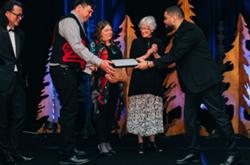[Editor's note: This is part two of Kai Nagata's Renaissance Man. It's the story of Matthew Wadsworth, a Montreal-based Renaissance lute virtuoso who wants to set a record for motorcycle jumping. He also happens to be blind since birth. Watch part one here. More on Kai Nagata, The Tyee's writer-in-residence, here.]
It's summer 1980 in the sleepy village of Haughton Green, outside Manchester. Ian Curtis, lead singer of Joy Division, has hanged himself just down the road. Margaret Thatcher is getting into the swing of things at 10 Downing Street. It's Matthew Wadsworth's sixth birthday. His father, Bill, leads him into the kitchen. Reaching forward, Matthew's hands touch rubber grips. A steel gas tank. It's a miniature motorcycle.
For the next four years, Matt rides his mini-bike nearly every day in the field behind the house. He wears a helmet and a little jumpsuit to keep off the mud. Neighbours learn to keep out of the way when the blind boy is tearing around the field. He does it all by feel. A local dog tries to play chicken one day and is sent flying. Bill explains to the irate owner that his son couldn't have done it on purpose.
This is the world Matt journeys back to in the second part of Renaissance Man. Nursing a sore shoulder after falling off his dirt bike in California, Matt needs a break from training -- and Micky needs time to rebuild the jump. It's been 26 years since Matt has been to Haughton Green, and he isn't sure how he'll feel when he arrives.
Filmmaking and 'natural constituencies'
Like part one, this instalment was produced in collaboration with fellow East Van kids Evan Crowe and Candice Vallantin.
We're trying to keep up with the story as it unfolds, and one of the cool things about Internet delivery is we can come pretty close. Releasing the film online opens up other possibilities, too. We don't have a distributor and we don't have a marketing budget, but what we're learning to tap into is potentially far more powerful.
What we do when we finish an episode of the documentary is send it to the people who have financed the project so far. PayPal provides us with their email addresses, so it's a simple matter of creating a list. Right now it's about 100 names, including those who have offered expertise and equipment in lieu of cash. The donors have the chance to watch the film first, and then -- if they like it -- it's up to them to post it on Facebook or Twitter, embed it in a blog, or send it to their friends.
I have a theory of what I call "natural constituencies": the close-knit groups of people online who respect each others' opinions enough to click on a 12-minute video. In this case, the So-Cal dirt bike community is a big one. Renaissance music enthusiasts. Indie doc lovers. DSLR nerds. Disability advocates. And of course the family and friends of the people involved. I think if you can speak to a few people in these natural constituencies, the magic of word-of-mouth takes over.
I'm not describing the classic "viral" spike we associate with finger-biting infants or cats too big for boxes. We are, after all, asking people to drop everything for 12 minutes and discover a story. There are a lot of other things legitimately competing for your attention. But if the "infection rate" is lower and slower, our hope is those who are engaged and intrigued by the project over time will become "carriers" with far more authority than a highway billboard or a pop-up ad.
The film, so the plan goes, will live online for as long as the YouTube servers keep humming away. In fact, there's no reason not to upload it to a different video hosting service. It will always be free to view, share, download, screen, subtitle, and mash up. And for a no-budget Canadian documentary, I'm impressed with the audience it's found already.
The model, on the other hand, has some built-in problems waiting to be worked out (the US electrical grid's dependence on coal, for example, or the jet fuel I burned following Matt to Manchester). We'll be addressing these issues -- and proposing solutions -- after the project wraps up. But I think the key discovery so far is this: when you eliminate the burning imperative to profit from cultural product, you become surprisingly efficient. When you reach out to the network you already have, you find surprising potential. A tiny crew on a shoestring budget can conceivably tackle a story that spans languages, lives, and continents. And viewers -- thousands of viewers, so far -- feel that much better about passing the story to their friends.
I hope you enjoy Part 2. Part 3 is coming soon, at the speed of the Internet.
[Tags: Film] ![]()
Read more: Film
















